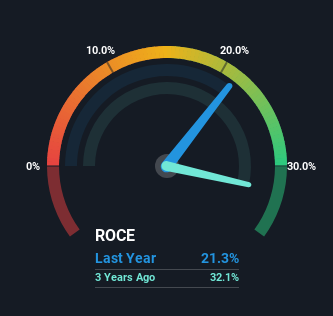- Hong Kong
- /
- Specialty Stores
- /
- SEHK:2209
The Returns On Capital At YesAsia Holdings (HKG:2209) Don't Inspire Confidence

What are the early trends we should look for to identify a stock that could multiply in value over the long term? One common approach is to try and find a company with returns on capital employed (ROCE) that are increasing, in conjunction with a growing amount of capital employed. Put simply, these types of businesses are compounding machines, meaning they are continually reinvesting their earnings at ever-higher rates of return. So when we looked at YesAsia Holdings (HKG:2209), they do have a high ROCE, but we weren't exactly elated from how returns are trending.
Understanding Return On Capital Employed (ROCE)
If you haven't worked with ROCE before, it measures the 'return' (pre-tax profit) a company generates from capital employed in its business. To calculate this metric for YesAsia Holdings, this is the formula:
Return on Capital Employed = Earnings Before Interest and Tax (EBIT) ÷ (Total Assets - Current Liabilities)
0.21 = US$9.3m ÷ (US$74m - US$31m) (Based on the trailing twelve months to December 2023).
Thus, YesAsia Holdings has an ROCE of 21%. That's a fantastic return and not only that, it outpaces the average of 10% earned by companies in a similar industry.
Check out our latest analysis for YesAsia Holdings

Historical performance is a great place to start when researching a stock so above you can see the gauge for YesAsia Holdings' ROCE against it's prior returns. If you'd like to look at how YesAsia Holdings has performed in the past in other metrics, you can view this free graph of YesAsia Holdings' past earnings, revenue and cash flow.
How Are Returns Trending?
When we looked at the ROCE trend at YesAsia Holdings, we didn't gain much confidence. While it's comforting that the ROCE is high, five years ago it was 53%. However, given capital employed and revenue have both increased it appears that the business is currently pursuing growth, at the consequence of short term returns. And if the increased capital generates additional returns, the business, and thus shareholders, will benefit in the long run.
On a side note, YesAsia Holdings has done well to pay down its current liabilities to 41% of total assets. So we could link some of this to the decrease in ROCE. Effectively this means their suppliers or short-term creditors are funding less of the business, which reduces some elements of risk. Some would claim this reduces the business' efficiency at generating ROCE since it is now funding more of the operations with its own money. Keep in mind 41% is still pretty high, so those risks are still somewhat prevalent.
The Bottom Line
In summary, despite lower returns in the short term, we're encouraged to see that YesAsia Holdings is reinvesting for growth and has higher sales as a result. And the stock has done incredibly well with a 518% return over the last year, so long term investors are no doubt ecstatic with that result. So while the underlying trends could already be accounted for by investors, we still think this stock is worth looking into further.
On a final note, we've found 2 warning signs for YesAsia Holdings that we think you should be aware of.
YesAsia Holdings is not the only stock earning high returns. If you'd like to see more, check out our free list of companies earning high returns on equity with solid fundamentals.
New: Manage All Your Stock Portfolios in One Place
We've created the ultimate portfolio companion for stock investors, and it's free.
• Connect an unlimited number of Portfolios and see your total in one currency
• Be alerted to new Warning Signs or Risks via email or mobile
• Track the Fair Value of your stocks
Have feedback on this article? Concerned about the content? Get in touch with us directly. Alternatively, email editorial-team (at) simplywallst.com.
This article by Simply Wall St is general in nature. We provide commentary based on historical data and analyst forecasts only using an unbiased methodology and our articles are not intended to be financial advice. It does not constitute a recommendation to buy or sell any stock, and does not take account of your objectives, or your financial situation. We aim to bring you long-term focused analysis driven by fundamental data. Note that our analysis may not factor in the latest price-sensitive company announcements or qualitative material. Simply Wall St has no position in any stocks mentioned.
About SEHK:2209
YesAsia Holdings
An investment holding company, engages in the procurement, sale, and trading of Asian fashion and lifestyle, beauty, cosmetics, accessories, and entertainment products.
Exceptional growth potential with flawless balance sheet.
Market Insights
Community Narratives




